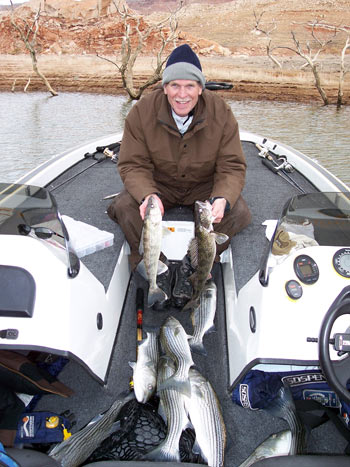 STRIPER
SAGE -- Here Gustavesen is shown enjoying the results of another
successful day of fishing. STRIPER
SAGE -- Here Gustavesen is shown enjoying the results of another
successful day of fishing.
Photo and Story by Wayne Gustavesen
Lake Elevaation: 3593
Water Temperature: 47-50
The northern lake is typical for late winter, with challenging fishing
for most species. Forage was abundant last fall.
Fish are fat and have gone dormant for the winter. There is very sparse
catching during daylight, with stripers providing more action at night
under fish-attracting lights.
The southern lake, accessed from Wahweap or Antelope Point, is the
place to be. Forage was scarce last fall, and stripers are hungry, making
them vulnerable to anglers. Two patterns are working well.
First, stripers are cruising main channel canyon walls from the dam to
Navajo Canyon. Best catches have come from the barricade line in front of
Glen Canyon Dam.
Tie the boat to the west side of the barricade line and cast anchovy
pieces on a small jig head toward the wall. Chum often.
Stripers usually hit as the bait is sinking. If no fish are caught
within an hour, try a different location.
The power plant intake, Antelope Canyon, and Navajo Canyon have
produced many stripers when fish are located in the channel as they are
now.
Second, some striper schools and individual fish are still in the backs
of the canyons from Warm Creek to Rock Creek. Schools hold at 25 feet and
make periodic sojourns into the very shallowest water.
Canyons with sandy beaches where aquatic weeds and sunken tumbleweeds
are emerging are the best spots. Small sunfish hiding in the weeds are
vulnerable to predators as the weeds dry up.
Use suspending crank baits fished with a stop-and-go retrieve for best
results. In very shallow water, a rattletrap fished along the bottom is
effective.
Walleye, smallmouth and largemouth bass are taking advantage of the
displaced bluegill as weeds dry up. Fish the same suspending crankbaits
and rattletraps near emerging brush piles and aquatic weeds to catch a
variety of predators guarding the cover for a chance to eat a small fish.
Fishing in the main channel of the lower lake is going to be good all
spring. Stripers are not finding shad forage in the back of the canyon as
they have the past 3 winters. Without shad, they move to the channel
following current as water flows through the dam.
This fishing is reminiscent of the early years when many learned to
fish for stripers using bait. The good old days are here again. Expect
bait fishing for stripers to be good for the next 2 months.
Glen Canyon dam is the closest and easiest fishing spot to find. The prime
spot is along the west wall near barricade buoys 2 through 4. A shallow
ledge attracts stripers to the spot while the remaining wall is sheer
cliff.
The drawback is that only a few boats can cast to the small ledge. If
the prime spot is taken, look for other rockslides or terraces along the
wall that may attract fish.
The NGS power Plant intake creates current and will attract stripers.
Sloping rock points in the main channel, Navajo, Antelope canyons, and the
mouth of Warm Creek will produce a large number of stripers to bait
anglers this spring.
If one spot is not working try the others to locate a personal school
of stripers. There will be an abundance of fish caught this spring in the
southern lake.
Use a small leadhead jig or circle hook with a light weight to let the
bait settle slowly to 20 to 60 feet. Cut the anchovy into one-inch chunks.
Put one on the hook and throw two in the water for chum.
Other game species are being caught sporadically but the main action is
for stripers drawn to current. Best fishing is in the south with only fair
fishing for all species in northern Lake Powell.
At press time, the advice was, if planning a lake trip now, go south
for better fishing; the lake elevation was at 3592, and the water
temperature was 47-50 F. No one knows where and how to catch stripers in
the Lake Powell area better than Wayne Gustavesen, who guides anglers with
his words every week at
www.waynes.words.com
|
 March
2006
March
2006